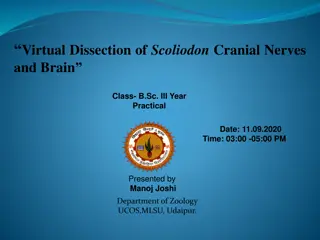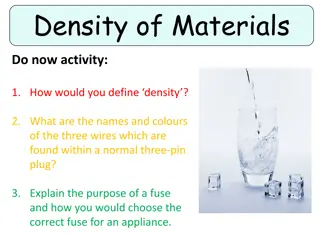Organizing a Dissection Practicum at the NIBI Symposium 2023
Explore the essential aspects of organizing a dissection practicum, including suitable animals, required tools, safety precautions, and appropriate supervision. Learn about different teaching methods and target audiences, as well as the importance of safety protocols and selecting fresh and appropri
0 views • 10 slides
Understanding Half-Life in Physics
Half-life is a key concept in physics, particularly in radioactive decay. It is the time taken for the activity of a radioactive source to decrease to half of its original value. This can be determined experimentally through measuring counts per minute and graphing the data. Additionally, half-life
2 views • 11 slides
Influence of Solar Activity and Orbital Motion on Terrestrial Atmosphere
Solar magnetic field reversal, wavelet spectral analysis, and proxies for solar activity index are discussed in relation to the joint effects of solar activity and solar orbital motion on the Earth's atmosphere. The study highlights the impact of solar cycles on terrestrial climate dynamics and temp
6 views • 16 slides
Modeling and Generation of Realistic Network Activity Using Non-Negative Matrix Factorization
The GHOST project focuses on the challenges of modeling, analyzing, and generating patterns of network activity. By utilizing Non-Negative Matrix Factorization (NMF), realistic network activity patterns can be created and injected into live wireless networks. Understanding and predicting user behavi
4 views • 28 slides
Overview of Neck Dissection in Head and Neck Cancer
Neck dissection is a crucial procedure for the prognostic and therapeutic management of head and neck cancers, particularly in cases where cancer has spread to the cervical lymph nodes. This process involves removing all lymph nodes and surrounding structures in the neck region to prevent the spread
8 views • 25 slides
Proper Scalpel Techniques in Anatomy Lab
Learn essential skills for handling scalpel blades in the anatomy lab, including mounting and removing blades safely. Understand different grip techniques to ensure precision and safety during dissection procedures. Follow step-by-step instructions with accompanying visuals for effective scalpel use
3 views • 18 slides
Virtual Dissection of Scoliodon Cranial Nerves and Brain: A Detailed Practical Guide
Explore the virtual dissection of Scoliodon's cranial nerves and brain in this informative practical session for B.Sc. III Year students. Learn about the anatomy and innervations of various nerves like Olfactory, Optic, Trigeminal, Facial, and more. Discover the phylum, group, and class of Scoliodon
0 views • 9 slides
Understanding Activity, Pay, and Special Codes in API Terminology
Dive into the terminology surrounding Activity Codes, Pay Codes, and Special Codes within the realm of APIs. Explore how these codes represent different aspects of scheduling, productivity, and payroll management. Gain insights into the distinctions between Activity Codes and Pay Codes, their implic
5 views • 8 slides
Exploring the Health Benefits of Exercise and Physical Activity at www.aber.ac.uk/ibers/
Delve into the relationship between physical activity, fitness, and mortality through insightful studies such as the Harvard Alumni Health Study and research by Paffenbarger et al. Discover the impact of exercise on reducing the risk of dying and improving overall health. Explore early work in sport
0 views • 12 slides
Understanding Density of Materials Activity
Density is defined as the mass per unit volume of a material. In this activity, students learn to measure and calculate the density of solid objects or liquids using the density equation. They also explore the concept of density through practical examples and self-assessment tasks. Additionally, the
0 views • 16 slides
Understanding Water Activity and Mass Transfer in Food Engineering
Water activity (aw) plays a crucial role in microbial activity, chemical and physical changes in foods, and the dehydration process. Maintaining water activity below specific levels can prevent microbiological spoilage and deterioration reactions, while also affecting texture, aroma, and overall qua
0 views • 11 slides
Interactive Mystery Chart Activity for Math Classroom
Engage your students with an interactive mystery chart activity to enhance their math skills. Utilize various sets of slides based on your class's needs, including options for distance learning. Use clues to deduce the number of dice in a glass, fostering estimation skills and logical thinking. The
0 views • 19 slides
Gel Electrophoresis DNA Extension Activity in Modern Biology Lab
This lab activity uses agarose gel electrophoresis to determine the length of an unknown DNA fragment by comparing it to known DNA fragment lengths. The process involves gel preparation, loading samples, electrophoresis, staining, de-staining, and measurement of DNA bands. The activity was produced
0 views • 7 slides
Interactive Football Top Trumps Game Activity for Year 3 Students
Engage Year 3 students in a fun and educational activity centered around designing and playing Top Trumps cards featuring famous footballers from Euro 2016. Students will research player statistics, create cards, establish rules, and play the game with classmates to enhance literacy and numeracy ski
0 views • 7 slides
Factors Affecting Enzyme Activity and Catalysis
Enzyme activity is influenced by various factors such as enzyme concentration, temperature, pH, substrate concentration, inhibitors, activators, and physical agents. The rate of enzyme-catalyzed reactions is directly proportional to enzyme concentration, and temperature plays a significant role with
0 views • 23 slides
Understanding Peroxidase Enzyme Activity in Biological Samples
Demonstrating the enzyme activity of peroxidase, an enzyme that plays a crucial role in breaking down hydrogen peroxide in various organisms. Learn about the differences between peroxidase and catalase, the calculation of enzyme activity, and the significance of extinction coefficient in enzyme assa
0 views • 8 slides
Understanding Article 6.2 Activity Cycle in Paris Agreement
Exploring the operationalization of Article 6.2 of the Paris Agreement through a private training series, this program focuses on capacity building for implementation and covers key aspects like the activity cycle, authorization processes, roles of governments, and project-level requirements. It del
0 views • 29 slides
Investigating Amylase Activity in Starch Digestion
An investigation on amylase activity involving the digestion of starch was conducted, with methods for controlling temperature, calculating digestion rates, and improving data precision discussed. The effects of temperature on enzymatic activity and precision enhancement techniques were explored.
0 views • 47 slides
Supporting Healthy Aging Through Physical Activity: Workshop Highlights
Explore the insights from an online workshop focusing on supporting healthy aging through physical activity for older adults. The workshop covers topics such as increasing awareness of the importance of physical activity, incorporating activities into daily routines, setting goals, and sustaining pr
0 views • 23 slides
Role of Lymphadenectomy in Genital Malignancies
Pelvic and paraaortic lymph node evaluation is crucial in the surgical staging of gynecological malignancies. The goals of lymph node dissection are to determine disease extent and guide further treatment. Pelvic lymph nodes include common iliac, external and internal iliac, obturator, sacral, and p
0 views • 16 slides
Engaging Mathematics Problems for Critical Thinking and Fun Learning
Explore a collection of engaging mathematics problems and classical brain teasers that challenge students to think critically, problem-solve creatively, and have fun while learning. From dissection tasks to card dealing challenges, these problems encourage students to readjust, reformulate, and exte
0 views • 36 slides
Frog Dissection Expectations and Procedures
Instructions for a frog dissection including preparation, tool usage, cutting techniques, organ exploration, and cleanup procedures. Students are guided on safety measures, dissection methods, organ identification, and proper cleanup steps after the activity. Detailed visual aids accompany each step
0 views • 6 slides
Fetal Pig Dissection Lab: Observing External Features and Respiratory System
In this detailed lab report on fetal pig dissection, students are tasked with observing the external features of the pig, determining its gender, examining teeth and skin, and studying the importance of the umbilical cord. The lab also delves into the respiratory system, focusing on cartilage rings,
0 views • 24 slides
Adherence to 2008 Physical Activity Guidelines & Mortality Study
This study explores the association between adherence to the 2008 Physical Activity Guidelines for Americans and all-cause mortality. It analyzes data from the NHIS and NDI to assess the risks associated with aerobic and muscle-strengthening activities. The primary objective is to evaluate mortality
0 views • 29 slides
Exploration of Scientific Temper and Critical Thinking in Ancient India
Delve into historical accounts showcasing the pursuit of scientific inquiry, challenging societal norms, and embracing critical thinking in ancient India through incidents involving Madhusudan Gupta, David Hare, and the revolutionary work of dissection. Explore the intersection of tradition and prog
0 views • 34 slides
Understanding Activity Diagrams and State Chart Diagrams
Activity diagrams describe the workflow behavior of a system by showing the sequence of activities performed, including conditional and parallel activities. Elements such as Initial Activity, Symbol Activity, Decisions, Signals, Concurrent Activities, and Final Activity are depicted in these diagram
0 views • 10 slides
Fine-Grained Dissection of WeChat in Cellular Networks
This study focuses on analyzing the traffic characteristics of WeChat, a popular mobile application, through a methodology called ChatDissect. The research delves into identifying message formats and semantics, distinguishing user behavior, and classifying traffic functionalities. Challenges in meas
0 views • 20 slides
Exploring the Anatomy of Eastern Oysters: A Detailed Study
Delve into the intricate anatomy of the Eastern Oyster (Crassostrea Virginica) through dissection and examination of its external and internal structures. Discover the fascinating details of oyster artifacts and evidence of organisms that coexisted with these marine creatures.
0 views • 36 slides
The Evolution of Cheerleading: From Yelling to Intense Physical Activity
Cheerleading ranges from yelling to intense physical activity, incorporating tumbling, dance, jumps, cheers, and stunting to motivate sports teams and entertain audiences. Originating in the United States, it has evolved from an all-male activity to a predominantly female sport with some co-ed teams
0 views • 9 slides
Virginia High School Survey 2015 Youth Risk Behavior Results
The Virginia High School Survey 2015 presented data on various risky behaviors among students, including seat belt usage, alcohol and drug consumption, weapon carrying, suicide attempts, physical activity, sexual activity, and more. The results are divided into percentages of students engaging in th
0 views • 4 slides
Interim Report of Harefield DCD Heart Transplant Programme Clinical Activity
The interim report highlights the clinical activity of the Harefield DCD Heart Transplant Programme, showcasing the feasibility of DCD heart transplantation using various methods. The report discusses donor/recipient risk profiles, feedback from medical teams, and the potential impact on national tr
0 views • 7 slides
Understanding Factors Affecting Enzyme Activity in Biochemistry
Enzyme assays measure substrate conversion to product under varying conditions like cofactors, pH, and temperature. Enzyme velocity represents the rate of a catalyzed reaction, typically reported as V0. Enzyme activity is expressed as mol of substrate transformed per minute, with enzyme unit and kat
0 views • 18 slides
Understanding Perch Anatomy and Classification
Discover the fascinating world of perch through detailed insights into their external and internal anatomy, classification in the animal kingdom, and interesting facts about the yellow perch species. Explore how gills work in respiration and learn essential dissection terms for a comprehensive under
0 views • 10 slides
Market Credit Working Group Update to Wholesale Market Subcommittee
The Market Credit Working Group provided updates to the Wholesale Market Subcommittee regarding NPRR review, focusing on NPRR 1088 which addresses credit impacts related to the elimination of RFAF and DFAF applications to prior and ongoing market positions. The discussion revolved around ERCOT credi
0 views • 8 slides
Exploring Crayfish Anatomy and Adaptations in Biology Lab
Explore the fascinating world of crayfish anatomy and adaptations through hands-on dissection activities in a biology lab setting. Identify phylum, examine external anatomy, study compound eyes, and delve into the function-form relationship within the phylum. Engage in interactive tasks like drawing
0 views • 22 slides
Chicken Wing Dissection and Observation Activity
Engage in a hands-on chicken wing dissection activity to explore how muscles, bones, and tendons work together. Follow the provided instructions to identify and understand the relationship between the skeletal and muscular systems. Conclude with a discussion on observations made during the dissectio
0 views • 11 slides
Emergency Cardiac Complication Management Algorithms
This comprehensive guide presents a series of algorithms for managing cardiac complications efficiently and systematically. It covers a range of scenarios such as unexpected hemodynamic collapse, no-reflow situations, and dissection cases. These algorithms provide step-by-step instructions for asses
0 views • 6 slides
Understanding Flower Dissection and Reproduction Process
Angiosperms are seed-bearing plants that produce flowers containing essential and accessory organs for reproductive functions. The stamen and pistil play key roles in the male and female reproductive processes, leading to fertilization and seed formation. Pollination, germination, and fruit developm
0 views • 14 slides
Ethics of Animal Experimentation in Medical Research
Exploring the application of utilitarianism to animal experimentation for medical research, this content delves into the history of vivisection, animal rights activism, and the work of historical figures like Claudius Galen in advancing medical understanding through dissection. The ethical considera
0 views • 17 slides
Activity Leader Guidelines for Volunteers
Welcome to the role of a leader, driver, or bus captain! As a leader, it is essential to familiarize yourself with the provided leader packets, understand the details of the activity, and prioritize safety. Taking pride in being a leader, owning the activity before the event, ensuring your packet is
0 views • 25 slides







































